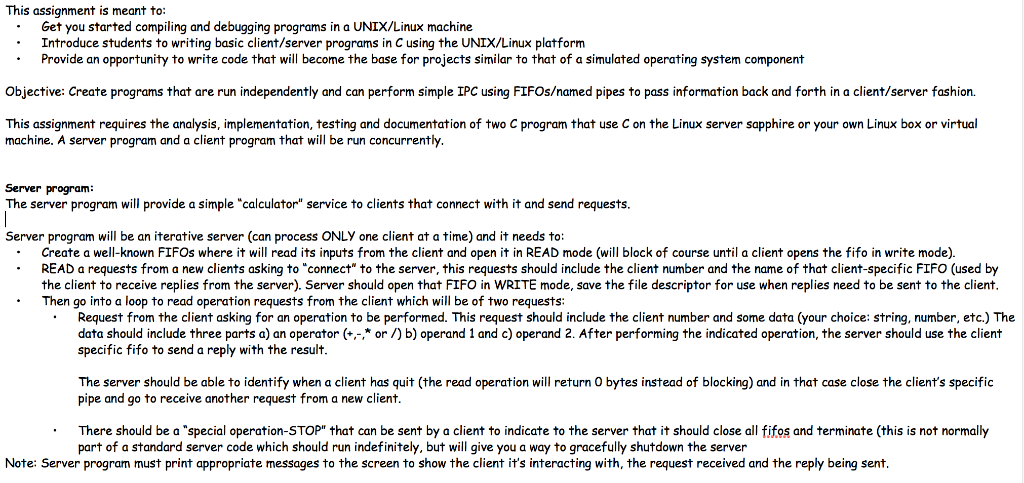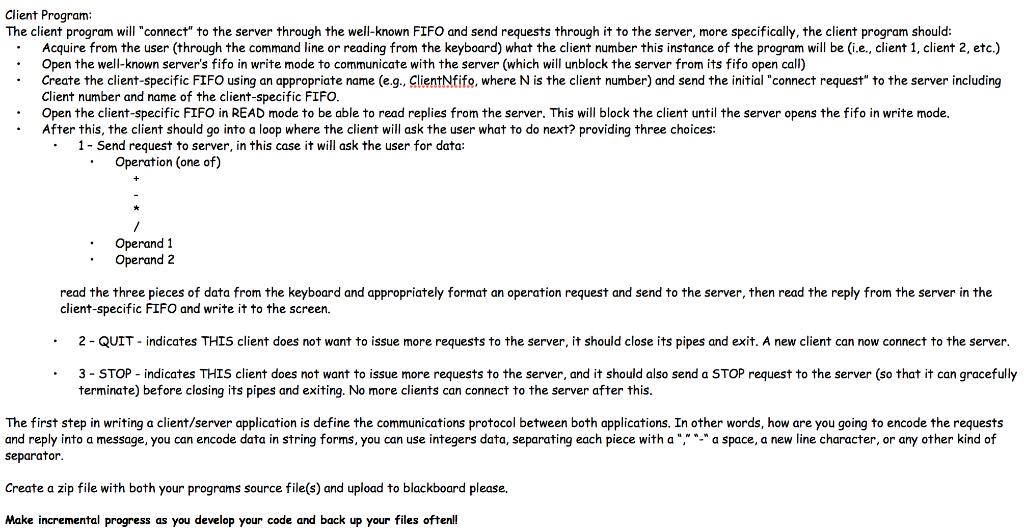Programming in C: Operating System


This assignment is meant to . Get you started compiling and debugging programs in a UNIX/Linux machine Introduce students to writing basic client/server programs in C using the UNIX/Linux platform Provide an opportunity to write code that will become the base for projects similar to that of a simulated operating system component Objective: Create programs that are run independently and can perform simple IPC using FIFOsamed pipes to pass information back and forth in a client/server fashion. This assignment requires the analysis, implementation, testing and documentation of two C program that use C on the Linux server sapphire or your own Linux box or virtual machine. A server program and a client program that will be run concurrently Server program The server program will provide a simple "calculator" service to clients that connect with it and send requests Server program will be an iterative server (can process ONLY one client at a time) and it needs to Create a well-known FIFOs where it will read its inputs from the client and open it in READ mode (will block of course until a client opens the fifo in write mode). .READ a requests from a new clients asking to "connect" to the server, this requests should include the client number and the name of that client-specific FIFO (used by the client to receive replies from the server). Server should open that FIFO in WRITE mode, save the file descriptor for use when replies need to be sent to the client Then go into a loop to read operation requests from the client which will be of two requests: Request from the client asking for an operation to be performed. This request should include the client number and some data (your choice: string, number, etc.) The data should include three parts a) an operator*or /)b) operand 1 and c) operand 2. After performing the indicated operation, the server should use the client specific fifo to send a reply with the result The server should be able to identify when a client has quit (the read operation will return 0 bytes instead of blocking) and in that case close the client's specific pipe and go to receive another request from a new client There should be a "special operation-STOP" that can be sent by a client to indicate to the server that it should close all fifos and terminate (this is not normally part of a standard server code which should run indefinitely, but will give you a way to gracefully shutdown the server Note: Server program must print appropriate messages to the screen to show the client it's interacting with, the request received and the reply being sent Client Program The client program will "connect" to the server through the well-known FIFO and send requests through it to the server, more specifically, the client program should: Acquire from the user (through the command line or reading from the keyboard) what the client number this instance of the program will be (i.e., client 1, client 2, etc.) .Open the well-known server's fifo in write mode to communicate with the server (which will unblock the server from its fifo open call) Create the client-specific FIFO using an appropriate name (e.g, ClientNfife, where N is the client number) and send the initial "connect request" to the server including Client number and name of the client-specific FIFO .Open the client-specific FIFO in READ mode to be able to read replies from the server. This will block the client until the server opens the fifo in write mode. . After this, the client should go into a loop where the client will ask the user what to do next? providing three choices: 1- Send request to server, in this case it will ask the user for data: Operation (one of) Operand 1 Operand 2 read the three pieces of data from the keyboard and appropriately format an operation request and send to the server, then read the reply from the server in the client-specific FIFO and write it to the screen. 2-QUIT-indicates THIS client does not want to issue more requests to the server, it should close its pipes and exit. A new client can now connect to the server. 3 - STOP-indicates THIS client does not want to issue more requests to the server, and it should also send a STOP request to the server (so that it can gracefully terminate) before closing its pipes and exiting. No more clients can connect to the server after this The first step in writing a client/server application is define the communications protocol between both applications. In other words, how are you going to encode the requests and reply into a message, you can encode data in string forms, you can use integers data, separating each piece with a "," -" a space, a new line character, or any other kind of separator Create a zip file with both your programs source file(s) and upload to blackboard please. Make incremental progress as you develop your code and back up your files often








